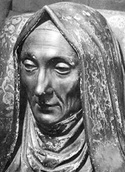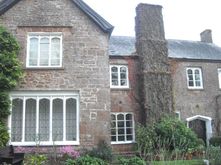Margaret Beaufort in Sampford Peverell
 Margaret Beaufort
Margaret Beaufort
Lady Margaret Beaufort, Countess of Richmond and Derby, who lived from 1443 to 1509, was a descendant of King Edward III, and therefore supported the Lancastrian side in the Wars of the Roses. She was married at the age of 12 to Edmund Tudor, 1st Earl of Richmond, the half brother of Henry VI, but Edmund died a year later leaving her 7 months pregnant. She gave birth at the age of 13 to her son, Henry Tudor.
Margaret married another two times but did not have any more children. During the reign of Richard III she made an arrangement with Elizabeth Woodville, the widow of Edward IV and mother of the murdererd 'princes in the tower', that Margaret's son Henry Tudor should marry Elizabeth's daughter Elizabeth of York, thus joining the houses of Lancaster and York. After Richard III's death at the Battle of Boswell Henry Tudor was crowned Henry VII and did indeed marry Elizabeth of York. As the King's mother Margaret became an important, possibly overbearing, figure at court, and it is rumoured that he 'encouraged' her to spend time away from London visiting her country estates. Henry VII died in 1509, and his son, Margaret's grandson, was crowned Henry VIII (he of the six wives). Margaret herself died later that same year.
Margaret had inherited a lot of land including estates in Devon, and her connections with Sampford Peverell are mentioned in the book 'The King's Mother: Lady Margaret Beaufort, Countess of Richmond and Derby' by Michael K Jones. He describes on pages 104, 141 and 220 how she had the Old Rectory built for her own use, had a watercourse diverted for use by a mill, and paid for alterations to the church, as follows:
Margaret married another two times but did not have any more children. During the reign of Richard III she made an arrangement with Elizabeth Woodville, the widow of Edward IV and mother of the murdererd 'princes in the tower', that Margaret's son Henry Tudor should marry Elizabeth's daughter Elizabeth of York, thus joining the houses of Lancaster and York. After Richard III's death at the Battle of Boswell Henry Tudor was crowned Henry VII and did indeed marry Elizabeth of York. As the King's mother Margaret became an important, possibly overbearing, figure at court, and it is rumoured that he 'encouraged' her to spend time away from London visiting her country estates. Henry VII died in 1509, and his son, Margaret's grandson, was crowned Henry VIII (he of the six wives). Margaret herself died later that same year.
Margaret had inherited a lot of land including estates in Devon, and her connections with Sampford Peverell are mentioned in the book 'The King's Mother: Lady Margaret Beaufort, Countess of Richmond and Derby' by Michael K Jones. He describes on pages 104, 141 and 220 how she had the Old Rectory built for her own use, had a watercourse diverted for use by a mill, and paid for alterations to the church, as follows:
 The Old Rectory
The Old Rectory
The Old Rectory is a grade 2 listed building and although it was heavily modified around 1900 it still, according to its listing, contains many high quality original or 16th century details.
In Philippa Gregory's historical novels, and the BBC TV adaptation "The White Queen', Margaret Beaufort is the character referred to as 'The Red Queen", referring to her allegiance to the Lancastrian side, symbolised by a red rose, in the War of the Roses.
Conditions of use.
The content of this website, including the transcriptions, can be freely accessed, printed and downloaded in an unaltered form with copyright acknowledged to The Sampford Peverell Society, for any non-commercial use. It may not be sold, licensed, transferred, copied or reproduced in whole or in part in any manner to any other person without prior written consent. Individuals and organisations wishing to make the content available through their websites may do so by means of hyperlinks to this site.
The content of this website, including the transcriptions, can be freely accessed, printed and downloaded in an unaltered form with copyright acknowledged to The Sampford Peverell Society, for any non-commercial use. It may not be sold, licensed, transferred, copied or reproduced in whole or in part in any manner to any other person without prior written consent. Individuals and organisations wishing to make the content available through their websites may do so by means of hyperlinks to this site.



